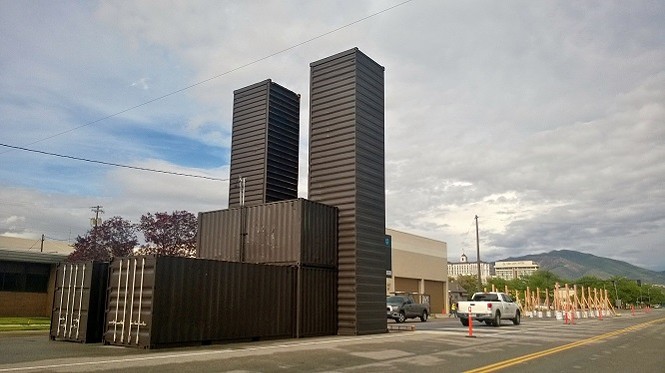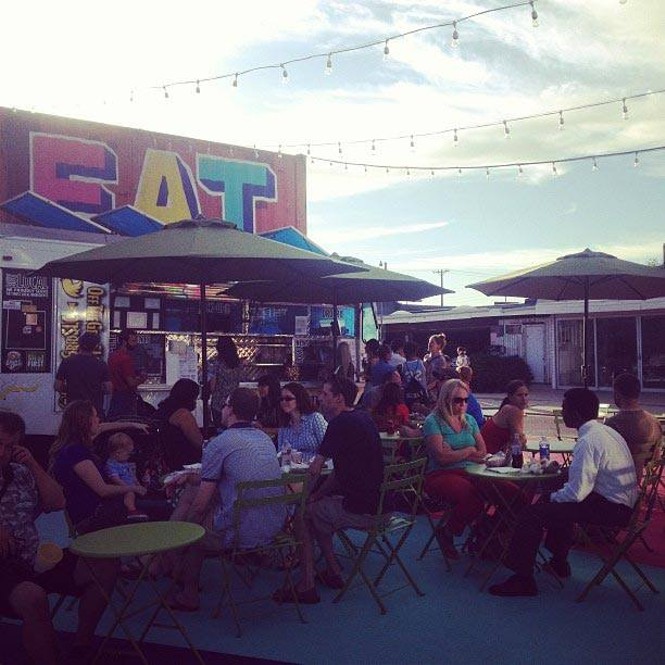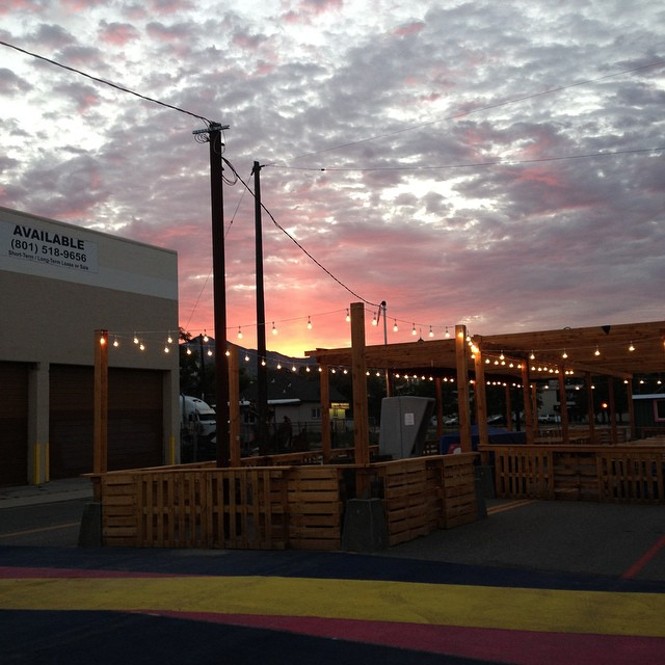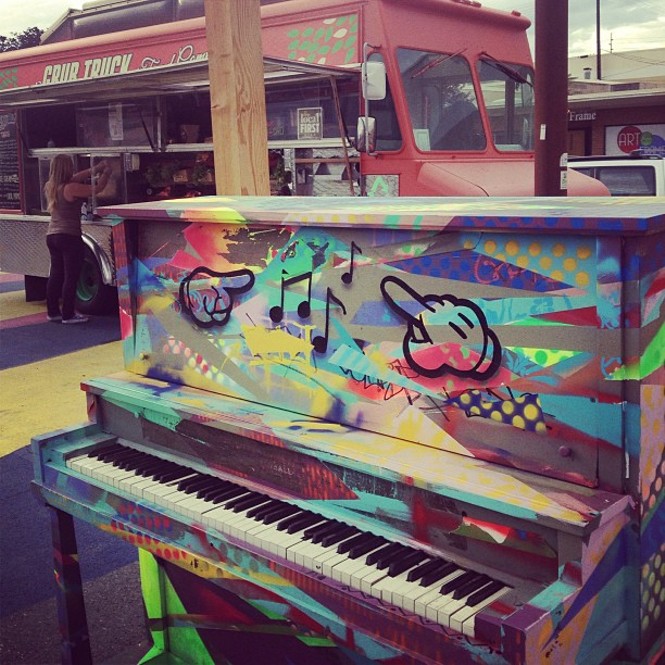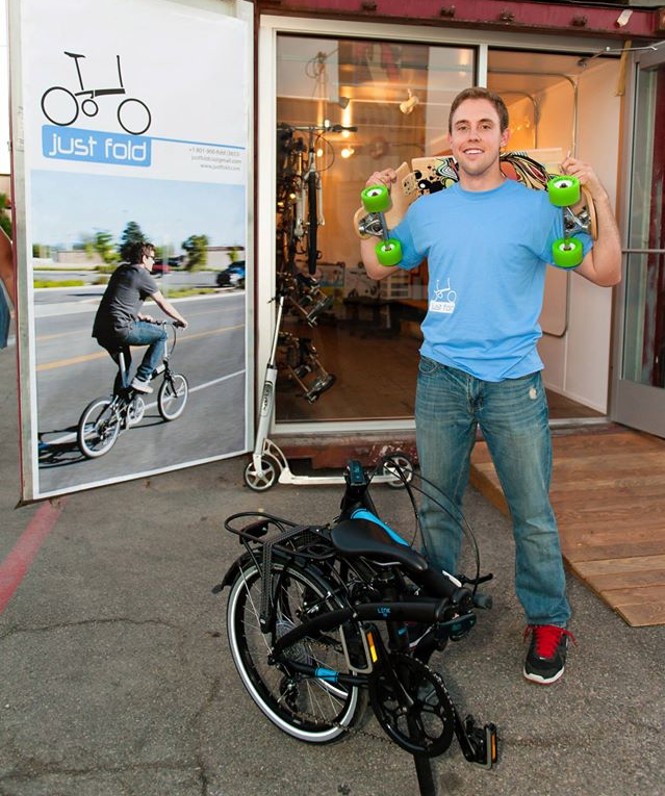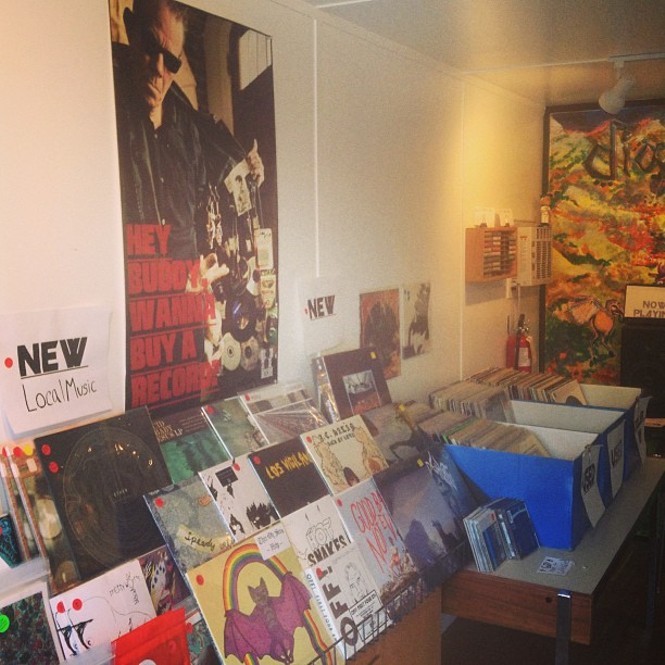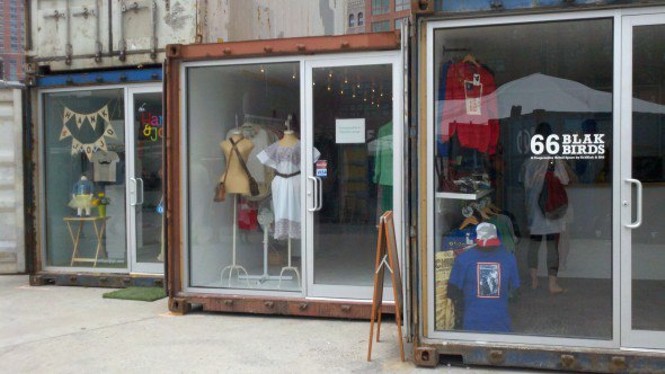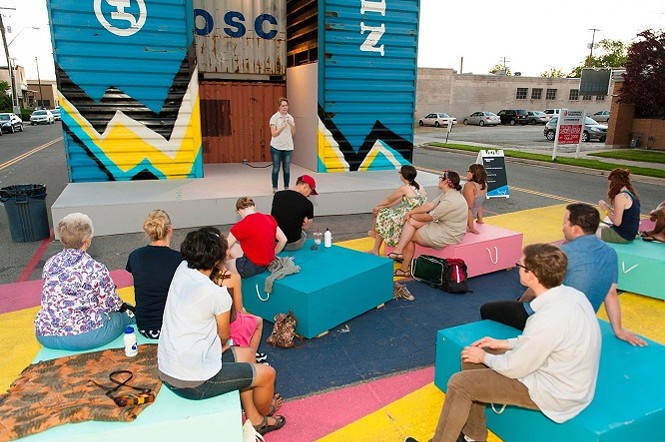Support the Free Press | Facts matter. Truth matters. Journalism matters
Salt Lake City Weekly has been Utah's source of independent news and in-depth journalism since 1984. Donate today to ensure the legacy continues.
Friday, June 5, 2015
Granary Row
After a two year hiatus, the summer event returns June 5
Posted By Gavin Sheehan on June 5, 2015, 12:00 PM
Back in the summer of 2013, Granary Row was an unexpected smash, bringing thousands of visitors every weekend to take part in an evening of shopping, dining, music and all-around enjoyment on one of SLC's less-traveled streets. After some apparent mixups and concerns prevented it from returning last year, the organizers worked hard to bring back the event and give the city another summer of fun. Tonight on 700 South between 3rd and 4th West, the Row will hold its grand opening for 2015. But before those festivities take place, we chat with one of the principal founders, Christian Harrison, about the highs and lows of running this unique experience, and what they have in store for the year. (All pictures courtesy of Granary Row.)
Christian Harrison
Granary Row on Facebook
Gavin: Hey Christian, first thing, tell us a little about yourself.
Christian: I grew up in Spokane, Wash.—the youngest child of a hard-working single woman. Coming out of a broken home, I found comfort in controlling my surroundings—whether it was rearranging my bedroom or taking on impromptu (unsupervised) landscaping projects. This evolved into a worldview that asked, “If I could, what would I change about this place?” As a child, this manifested itself in my desire to be an architect. Then in high school, it was a motivating factor in my interest in politics… at BYU. I turned another corner and began to be very involved in urban development circles. And here I am today: partner at Kentlands Initiative, an urban development firm—not to mention my chairing the boards of Downtown Community Council and Utah Transit Riders Union. So it would appear that I’m living the dream!
Gavin: You came to us from Washington; what made you move to Utah and how has it been living here since?
Christian: I came to Utah in 1993 to attend BYU, where I studied International Relations, French, Mandarin and Danish. At the dawn of the Internet age, I co-founded a few tech start-ups and remained with the tech sector through the Bubble and even through the Great Recession. I was always involved in communications and visioning. Today, I continue to work in the communications/government/public relations space. I lived in Provo for 12 years and loved it—loved my neighbors and loved the small city charms. But after a while, I realized that I was a little too old (and a lot too gay) to stay. So I sold my home in Provo and bought a condo on Pioneer Park. I’d been coming to the Downtown Farmers Market for the better part of a decade, and I fell in love with the neighborhood. So when I found a place here, I snatched it up. I’ve lived in my little flat overlooking Pioneer Park for a decade now—and I can scarcely imagine living anywhere else... though London is a perennial temptation.
Gavin: How did the idea for Granary Row come about?
Christian: The Kentlands Initiative hosted a week-long design workshop (they’re called “charrettes” in the industry) where we had more than 500 neighbors participate. That workshop produced a 60-page project book, and Granary Row was one of those projects. That’s the short answer. The longer answer is that at the workshop, we asked participants time and again: What are the neighborhood’s assets, what are its liabilities? And on both lists, were the roads. These enormous, practically empty roads are 132 feet wide (that’s nearly three times wider than an average US street) and they consume 30 percent of the Granary District’s land area. 30 percent! Imagine what we could do if we could put these roads to work for us? So that’s just what we did. And from there, we talked about ways the neighborhood could repurpose parts of these roads to achieve neighborhood goals—park space, business incubator space, residential space, community space. And that’s really what Granary Row is about—an experiment to see if repurposing a road was possible. Once we had the idea, we knew we had to act on it quickly—the best ideas can also be the most fleeting. So in August of 2012, James Alfandre (Kentlands Initiative Executive Director) and I set to work and in May we opened our doors—that’s start to finish in a little more than eight months!
Gavin: What was it like planning the initial idea out and working with the group of people?
Christian: From the beginning, we knew that Granary Row had to build the public workshop that created it—so we had neighborhood “coffee klatches” (where no coffee, but plenty of beer, flowed) where neighbors came together to pull it off. It was a wonderful thing to watch. We use coffee klatches for all sorts of Granary District projects—so neighbors and allies should keep their eyes peeled for klatch invitations on the Granary District Facebook page.
Gavin: What made you choose the location on 700 South, and how was it working with the city to secure the spot?
Christian: The Granary District is a big area, 100 acres, and we’re only now seeing the formation of smaller neighborhoods within it. The biggest of these neighborhoods, Central Ninth, is doing amazing things. So Kentlands Initiative looked for a development node that was on the edge of something bigger. And that’s exactly what we have at the corner of 700 South and 300 West—Pictureline and Kilby Court are right there, Ruby Snap is just around the corner. We believed that if we were going to bring the crowds, then creative people would see what was already there and would begin to do the hard work of taking that node to the next level. The City was good to work with. Bob Ferrington and Frank Gray were early supporters, as were City Councilors Kyle LaMalfa and Luke Garrott. But it was Mayor Becker's vocal support of the project that eased our way through the process. Let’s face it: Nothing like Granary Row had ever been done in Salt Lake City. In fact, we’re pretty confident that Granary Row was the first development of its kind in the country. So it took a great deal of vision and patience to figure out a way to make it work. And we did.
Gavin: What was the process like in getting the shipping containers and turning those into a viable space for places to do business?
Christian: We purchased most of the containers from a local company, Pac-Van, who repurposes used containers for all sorts of projects in the region. Once we had the containers, the amazing guys over at United Contractors, with direction from local architect (and Granary Row neighbor) Kevin Blaloch and vigilant oversight from James Alfandre—fitted them out with drywall, insulation, power, lights, air conditioning, and glass doors.
Gavin: How did you go about finding people to take part in the event, and how much of a challenge was it convincing people the plan would work out?
Christian: Using our neighborhood network, we reached out to all sorts of vendors, artisans and vendors. We also reached out to the broader Salt Lake community via our friends at Local First, Downtown Farmers Market, Salt Lake City Arts Council, among others. Some of our best retailers came by word of mouth. Finding people was difficult. But once they saw what we were doing, they got it. It’s really an infectious idea—turning an unused resource into something wonderful, useful. Especially when it’s filled with a playful spirit.
Gavin: What was the initial run like for the first few weeks when you started in 2013?
Christian: James and I initially envisioned that Granary Row would run Thursday and Friday nights, and Saturdays all day for about six months. Our first wake-up call came the first Saturday. The temps were high, and Granary Row was a ghost town. We powwowed with the vendors and decided to not be open Saturdays until 6 p.m. Aside from that hiccup, the first few weeks were wonderful.
Gavin: What were some of the unexpected surprises you ran across, both positive and negative?
Christian: We were surprised by the turnout. We were surprised by the attention the project got both locally and nationally/internationally. Folks are hungry for new ways to improve their cities. We were also surprised at how smoothly things ran. The retailers and vendors and guests made hosting Granary Row a pleasure. And for a venue that featured alcohol sales, we were surprised that, at the end of the season, we’d not had any need to call for a taxi, a cop, or worse. We had a perfect safety score. We’re pretty proud of that. The weather was difficult. 2013 was a very hot summer—with several powerful electrical storms that shut us down. And then, at the end of the season, we were surprised by how fast it got cold. We were surprised by how thoroughly Twilight Concerts monopolized Thursday nights. We had really small crowds on Thursdays. This season, we decided to skip Thursdays and are only open Friday and Saturday nights. Those were the big downers for us.
Gavin: What was the overall feeling with the event once you finished the 2013 run?
Christian: Elation! It was a huge success—but after six months, everyone was tired. Our closing night featured flying acrobats and fire dancers. It was wonderful. But even better was, at the very end, when I got to thank everyone and wish them all luck. Three of our start-up retailers went on to look for storefronts in the area, Diabolical Records and Mineral & Matter eventually found places. We also launched Cherry’s Hot Cocoa, Grub, and Wilma’s food trucks—all of which have remained a vital part of Salt Lake City’s food scene. So, yeah, elation.
Gavin: For those who may not be aware, what was the issue you ran into that caused the 2014 season to not happen?
Christian: Our second season was meant to be last year, but it didn’t happen. A couple of people at the city didn’t share our vision, and without their support, the permitting process dragged on too long. Some changes in staffing, though, cleared up the roadblocks and this year we were able to take our project through the process. We are especially thankful for the support of Jill Remington Love and Mary De la Mare Schaeffer. Granary Row remains a cutting-edge project—but their patience, vision and perseverance really made a big difference.
Gavin: Once you knew you weren’t coming back in 2014, what steps did you take to assure you would be returning this year?
Christian: We immediately began planning a two-night event to hold, mid-summer—in order to keep the pilot light burning, so to speak. We also began to re-examine our approach to permitting. At some point during the summer, City Councilman Kyle LaMalfa said to James, “Why don’t you just take the lease you had for 2013, white out the dates and get it signed again.” It was a breath of fresh thinking that re-energized us, and it was the blueprint for our successful permitting process this year.
Gavin: What specifically will change this year compared to 2013?
Christian: First, our season and hours of operation. We’ve gone from 6 months to 3, June 5 through Aug. 22. And from three nights to two, Friday and Saturday nights, 6-10 p.m. (last call at the biergarten is 10:45). We also handed off-key elements of site management to partners. Tom Bennett of Sweet Salt Records is managing the stage and has completely booked out the entire season! Also, the food trucks are being managed by Food Truck Underground. As for the site, the biggest changes that have happened are all a result of our seeking input from neighbors. Item 1: Granary Row was festive when it was open—with lights and music and people. But during the day, our site looked like a pile of abandoned cargo containers. And that’s not the image the neighborhood wanted or deserved. So we chose a crisp uniform color to paint the containers and we’re bringing in more on-site container plantings. Item 2: Being in the middle of the road and having traffic pass us on both sides meant that we pretty much created two one-way streets. Which was confusing for motorists. This year, we shifted the site north 20 feet and created a properly-sized two-way street on our south and a private lane for business deliveries on our north.
Gavin: A lot of people have been asking about the Biergarten and live performances. What will be happening as far as those entities?
Christian: The Biergarten is being managed by Janice Boes of Pierpont Place. Her team brings a lot of experience to the table. For patrons, the experience will be the same as our first season. The stage is completely booked, with local and touring acts taking the stage at 7:30 and 9 p.m. each night. We’re also partnering with our neighbors at MusicGarage to feature some of their talented youth artists several nights, with their performances starting at 6 p.m. Information about our line-up is available on our Facebook page.
Gavin: For those interested, what vendors will you have on tap as permanent fixtures during the three-month run?
Christian: We’re opening with six vendors: Daley’s Menswear, Big Cartel, Iron Rose Collection, Maeberry Vintage, Mineral & Matter, Spice Kitchen and Velo City
Gavin: Is there anything else you'd like to tell people about the row before it kicks off on Friday?
Christian: Granary Row started at a public workshop that sought to envision a brighter future for a hard-pressed neighborhood. Today, Granary Row is a catalyst for the change that neighbors, allies, and Kentlands Initiative are working towards. But it's only been possible because people crave what Granary Row offers: a place that is extraordinary—a place where memories are made. So come on down, grab a pint, take some selfies, shop our stores, and get your dance monster on!
Christian Harrison
Granary Row on Facebook
Gavin: Hey Christian, first thing, tell us a little about yourself.
Christian: I grew up in Spokane, Wash.—the youngest child of a hard-working single woman. Coming out of a broken home, I found comfort in controlling my surroundings—whether it was rearranging my bedroom or taking on impromptu (unsupervised) landscaping projects. This evolved into a worldview that asked, “If I could, what would I change about this place?” As a child, this manifested itself in my desire to be an architect. Then in high school, it was a motivating factor in my interest in politics… at BYU. I turned another corner and began to be very involved in urban development circles. And here I am today: partner at Kentlands Initiative, an urban development firm—not to mention my chairing the boards of Downtown Community Council and Utah Transit Riders Union. So it would appear that I’m living the dream!
Gavin: You came to us from Washington; what made you move to Utah and how has it been living here since?
Christian: I came to Utah in 1993 to attend BYU, where I studied International Relations, French, Mandarin and Danish. At the dawn of the Internet age, I co-founded a few tech start-ups and remained with the tech sector through the Bubble and even through the Great Recession. I was always involved in communications and visioning. Today, I continue to work in the communications/government/public relations space. I lived in Provo for 12 years and loved it—loved my neighbors and loved the small city charms. But after a while, I realized that I was a little too old (and a lot too gay) to stay. So I sold my home in Provo and bought a condo on Pioneer Park. I’d been coming to the Downtown Farmers Market for the better part of a decade, and I fell in love with the neighborhood. So when I found a place here, I snatched it up. I’ve lived in my little flat overlooking Pioneer Park for a decade now—and I can scarcely imagine living anywhere else... though London is a perennial temptation.
Gavin: How did the idea for Granary Row come about?
Christian: The Kentlands Initiative hosted a week-long design workshop (they’re called “charrettes” in the industry) where we had more than 500 neighbors participate. That workshop produced a 60-page project book, and Granary Row was one of those projects. That’s the short answer. The longer answer is that at the workshop, we asked participants time and again: What are the neighborhood’s assets, what are its liabilities? And on both lists, were the roads. These enormous, practically empty roads are 132 feet wide (that’s nearly three times wider than an average US street) and they consume 30 percent of the Granary District’s land area. 30 percent! Imagine what we could do if we could put these roads to work for us? So that’s just what we did. And from there, we talked about ways the neighborhood could repurpose parts of these roads to achieve neighborhood goals—park space, business incubator space, residential space, community space. And that’s really what Granary Row is about—an experiment to see if repurposing a road was possible. Once we had the idea, we knew we had to act on it quickly—the best ideas can also be the most fleeting. So in August of 2012, James Alfandre (Kentlands Initiative Executive Director) and I set to work and in May we opened our doors—that’s start to finish in a little more than eight months!
Gavin: What was it like planning the initial idea out and working with the group of people?
Christian: From the beginning, we knew that Granary Row had to build the public workshop that created it—so we had neighborhood “coffee klatches” (where no coffee, but plenty of beer, flowed) where neighbors came together to pull it off. It was a wonderful thing to watch. We use coffee klatches for all sorts of Granary District projects—so neighbors and allies should keep their eyes peeled for klatch invitations on the Granary District Facebook page.
Gavin: What made you choose the location on 700 South, and how was it working with the city to secure the spot?
Christian: The Granary District is a big area, 100 acres, and we’re only now seeing the formation of smaller neighborhoods within it. The biggest of these neighborhoods, Central Ninth, is doing amazing things. So Kentlands Initiative looked for a development node that was on the edge of something bigger. And that’s exactly what we have at the corner of 700 South and 300 West—Pictureline and Kilby Court are right there, Ruby Snap is just around the corner. We believed that if we were going to bring the crowds, then creative people would see what was already there and would begin to do the hard work of taking that node to the next level. The City was good to work with. Bob Ferrington and Frank Gray were early supporters, as were City Councilors Kyle LaMalfa and Luke Garrott. But it was Mayor Becker's vocal support of the project that eased our way through the process. Let’s face it: Nothing like Granary Row had ever been done in Salt Lake City. In fact, we’re pretty confident that Granary Row was the first development of its kind in the country. So it took a great deal of vision and patience to figure out a way to make it work. And we did.
Gavin: What was the process like in getting the shipping containers and turning those into a viable space for places to do business?
Christian: We purchased most of the containers from a local company, Pac-Van, who repurposes used containers for all sorts of projects in the region. Once we had the containers, the amazing guys over at United Contractors, with direction from local architect (and Granary Row neighbor) Kevin Blaloch and vigilant oversight from James Alfandre—fitted them out with drywall, insulation, power, lights, air conditioning, and glass doors.
Gavin: How did you go about finding people to take part in the event, and how much of a challenge was it convincing people the plan would work out?
Christian: Using our neighborhood network, we reached out to all sorts of vendors, artisans and vendors. We also reached out to the broader Salt Lake community via our friends at Local First, Downtown Farmers Market, Salt Lake City Arts Council, among others. Some of our best retailers came by word of mouth. Finding people was difficult. But once they saw what we were doing, they got it. It’s really an infectious idea—turning an unused resource into something wonderful, useful. Especially when it’s filled with a playful spirit.
Gavin: What was the initial run like for the first few weeks when you started in 2013?
Christian: James and I initially envisioned that Granary Row would run Thursday and Friday nights, and Saturdays all day for about six months. Our first wake-up call came the first Saturday. The temps were high, and Granary Row was a ghost town. We powwowed with the vendors and decided to not be open Saturdays until 6 p.m. Aside from that hiccup, the first few weeks were wonderful.
Gavin: What were some of the unexpected surprises you ran across, both positive and negative?
Christian: We were surprised by the turnout. We were surprised by the attention the project got both locally and nationally/internationally. Folks are hungry for new ways to improve their cities. We were also surprised at how smoothly things ran. The retailers and vendors and guests made hosting Granary Row a pleasure. And for a venue that featured alcohol sales, we were surprised that, at the end of the season, we’d not had any need to call for a taxi, a cop, or worse. We had a perfect safety score. We’re pretty proud of that. The weather was difficult. 2013 was a very hot summer—with several powerful electrical storms that shut us down. And then, at the end of the season, we were surprised by how fast it got cold. We were surprised by how thoroughly Twilight Concerts monopolized Thursday nights. We had really small crowds on Thursdays. This season, we decided to skip Thursdays and are only open Friday and Saturday nights. Those were the big downers for us.
Gavin: What was the overall feeling with the event once you finished the 2013 run?
Christian: Elation! It was a huge success—but after six months, everyone was tired. Our closing night featured flying acrobats and fire dancers. It was wonderful. But even better was, at the very end, when I got to thank everyone and wish them all luck. Three of our start-up retailers went on to look for storefronts in the area, Diabolical Records and Mineral & Matter eventually found places. We also launched Cherry’s Hot Cocoa, Grub, and Wilma’s food trucks—all of which have remained a vital part of Salt Lake City’s food scene. So, yeah, elation.
Gavin: For those who may not be aware, what was the issue you ran into that caused the 2014 season to not happen?
Christian: Our second season was meant to be last year, but it didn’t happen. A couple of people at the city didn’t share our vision, and without their support, the permitting process dragged on too long. Some changes in staffing, though, cleared up the roadblocks and this year we were able to take our project through the process. We are especially thankful for the support of Jill Remington Love and Mary De la Mare Schaeffer. Granary Row remains a cutting-edge project—but their patience, vision and perseverance really made a big difference.
Gavin: Once you knew you weren’t coming back in 2014, what steps did you take to assure you would be returning this year?
Christian: We immediately began planning a two-night event to hold, mid-summer—in order to keep the pilot light burning, so to speak. We also began to re-examine our approach to permitting. At some point during the summer, City Councilman Kyle LaMalfa said to James, “Why don’t you just take the lease you had for 2013, white out the dates and get it signed again.” It was a breath of fresh thinking that re-energized us, and it was the blueprint for our successful permitting process this year.
Gavin: What specifically will change this year compared to 2013?
Christian: First, our season and hours of operation. We’ve gone from 6 months to 3, June 5 through Aug. 22. And from three nights to two, Friday and Saturday nights, 6-10 p.m. (last call at the biergarten is 10:45). We also handed off-key elements of site management to partners. Tom Bennett of Sweet Salt Records is managing the stage and has completely booked out the entire season! Also, the food trucks are being managed by Food Truck Underground. As for the site, the biggest changes that have happened are all a result of our seeking input from neighbors. Item 1: Granary Row was festive when it was open—with lights and music and people. But during the day, our site looked like a pile of abandoned cargo containers. And that’s not the image the neighborhood wanted or deserved. So we chose a crisp uniform color to paint the containers and we’re bringing in more on-site container plantings. Item 2: Being in the middle of the road and having traffic pass us on both sides meant that we pretty much created two one-way streets. Which was confusing for motorists. This year, we shifted the site north 20 feet and created a properly-sized two-way street on our south and a private lane for business deliveries on our north.
Gavin: A lot of people have been asking about the Biergarten and live performances. What will be happening as far as those entities?
Christian: The Biergarten is being managed by Janice Boes of Pierpont Place. Her team brings a lot of experience to the table. For patrons, the experience will be the same as our first season. The stage is completely booked, with local and touring acts taking the stage at 7:30 and 9 p.m. each night. We’re also partnering with our neighbors at MusicGarage to feature some of their talented youth artists several nights, with their performances starting at 6 p.m. Information about our line-up is available on our Facebook page.
Gavin: For those interested, what vendors will you have on tap as permanent fixtures during the three-month run?
Christian: We’re opening with six vendors: Daley’s Menswear, Big Cartel, Iron Rose Collection, Maeberry Vintage, Mineral & Matter, Spice Kitchen and Velo City
Gavin: Is there anything else you'd like to tell people about the row before it kicks off on Friday?
Christian: Granary Row started at a public workshop that sought to envision a brighter future for a hard-pressed neighborhood. Today, Granary Row is a catalyst for the change that neighbors, allies, and Kentlands Initiative are working towards. But it's only been possible because people crave what Granary Row offers: a place that is extraordinary—a place where memories are made. So come on down, grab a pint, take some selfies, shop our stores, and get your dance monster on!
On Topic...
-
Film Reviews: New Releases for April 19
The Ministry of Ungentlemanly Warfare, Abigail, The Beast, Hard Miles, Sasquatch Sunset and more
- Apr 19, 2024
-
Film Reviews: New Releases for April 12
Civil War, Escape from Germany, Coup de Chance, Hundreds of Beavers, La Chimera, Sting
- Apr 11, 2024
-
Film Reviews: New Releases for April 5
Monkey Man, The First Omen, Wicked Little Letters, Girls State, Scoop, Exhuma
- Apr 4, 2024
- More Gavin's Underground » More Culture »
More by Gavin Sheehan
-
Gavin's Underground: End Of An Era
Nine and a half years of local entertainment blogging comes to an end.
- May 26, 2017
-
Torris Fairley
A quick interview with the up-and-coming SLC-based comedian.
- May 25, 2017
-
Cirque Asylum
A look into the dance school teaching unique forms of aerial arts.
- May 24, 2017
- More »




